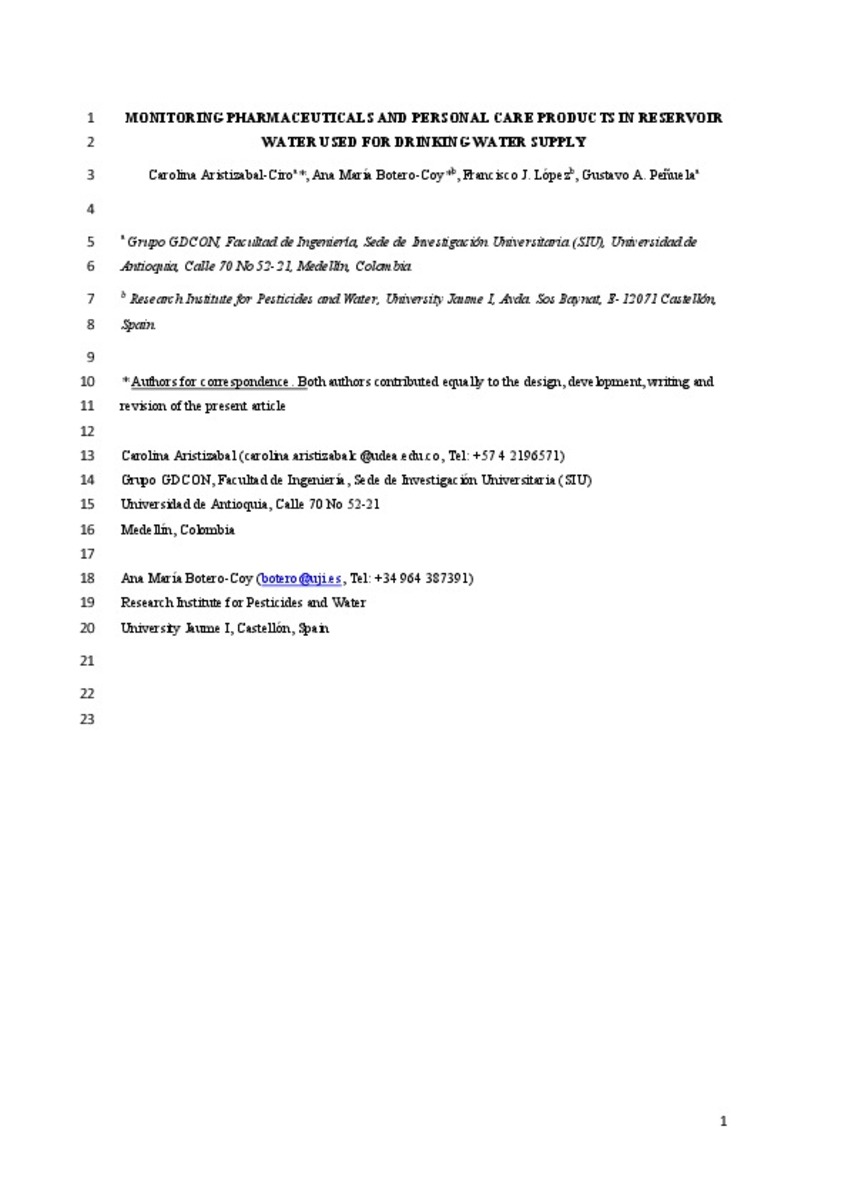Mostrar el registro sencillo del ítem
Monitoring pharmaceuticals and personal care products in reservoir water used for drinking water supply
| dc.contributor.author | Aristizábal Ciro, Carolina | |
| dc.contributor.author | Botero-Coy, Ana Maria | |
| dc.contributor.author | Lopez, Francisco | |
| dc.contributor.author | Peñuela, Gustavo | |
| dc.date.accessioned | 2017-07-03T09:33:41Z | |
| dc.date.available | 2017-07-03T09:33:41Z | |
| dc.date.issued | 2017-03 | |
| dc.identifier.citation | ARISTIZÁBAL CIRO, Carolina; BOTERO COY, Ana María; LÓPEZ BENET, Francisco José; PEÑUELA, Gustavo A. Monitoring pharmaceuticals and personal care products in reservoir water used for drinking water supply. Environmental Science and Pollution Research (2017), v. 24, issue 8, pp. 7335-7347 | ca_CA |
| dc.identifier.uri | http://hdl.handle.net/10234/168163 | |
| dc.description.abstract | In this work, the presence of selected emerging contaminants has been investigated in two reservoirs, La Fe (LF) and Rio Grande (RG), which supply water to two drinking water treatment plants (DWTPs) of Medellin, one of the most populated cities of Colombia. An analytical method based on solid-phase extraction (SPE) of the sample followed by measurement by liquid chromatography coupled to tandem mass spectrometry (LC– MS/MS) was developed and validated for this purpose. Five monitoring campaigns were performed in each reservoir, collecting samples from 7 sites (LF) and 10 sites (RG) at 3 different depths of the water column. In addition, water samples entering in the DWTPs and treated water samples from these plans were also analysed for the selected compounds. Data from this work showed that parabens, UV filters and the pharmaceutical ibuprofen were commonly present in most of the reservoir samples. Thus, methyl paraben was detected in around 90% of the samples collected, while ibuprofen was found in around 60% of the samples. Water samples feeding the DWTPs also contained these two compounds, as well as benzophenone at low concentrations, which was in general agreement with the results from the reservoir samples. After treatment in the DWTPs, these three compounds were still present in the samples although at low concentrations (<40 ng/L), which evidenced that they were not completely removed after the conventional treatment applied. The potential effects of the presence of these compounds at the ppt levels in drinking water are still unknown. Further research is needed to evaluate the effect of chronic exposure to these compounds via consumption of drinking water. | ca_CA |
| dc.description.sponsorShip | his work has been developed under the financial support provided by Empresa Públicas de Medellin. | ca_CA |
| dc.format.extent | 13 p. | ca_CA |
| dc.format.mimetype | application/pdf | ca_CA |
| dc.language.iso | eng | ca_CA |
| dc.publisher | Springer | ca_CA |
| dc.relation.isPartOf | Environmental Science and Pollution Research (2017), v. 24, issue 8 | ca_CA |
| dc.rights.uri | http://rightsstatements.org/vocab/CNE/1.0/ | * |
| dc.subject | Emerging contaminants | ca_CA |
| dc.subject | Personal care products | ca_CA |
| dc.subject | Pharmaceuticals | ca_CA |
| dc.subject | UHPLC/MS/MS | ca_CA |
| dc.subject | Drinking water | ca_CA |
| dc.subject | Reservoir water | ca_CA |
| dc.title | Monitoring pharmaceuticals and personal care products in reservoir water used for drinking water supply | ca_CA |
| dc.type | info:eu-repo/semantics/article | ca_CA |
| dc.identifier.doi | http://dx.doi.org/10.1007/s11356-016-8253-1 | |
| dc.rights.accessRights | info:eu-repo/semantics/openAccess | ca_CA |
| dc.relation.publisherVersion | https://link.springer.com/article/10.1007/s11356-016-8253-1 | ca_CA |
| dc.type.version | info:eu-repo/semantics/submittedVersion |
Ficheros en el ítem
Este ítem aparece en la(s) siguiente(s) colección(ones)
-
IUPA_Articles [306]







